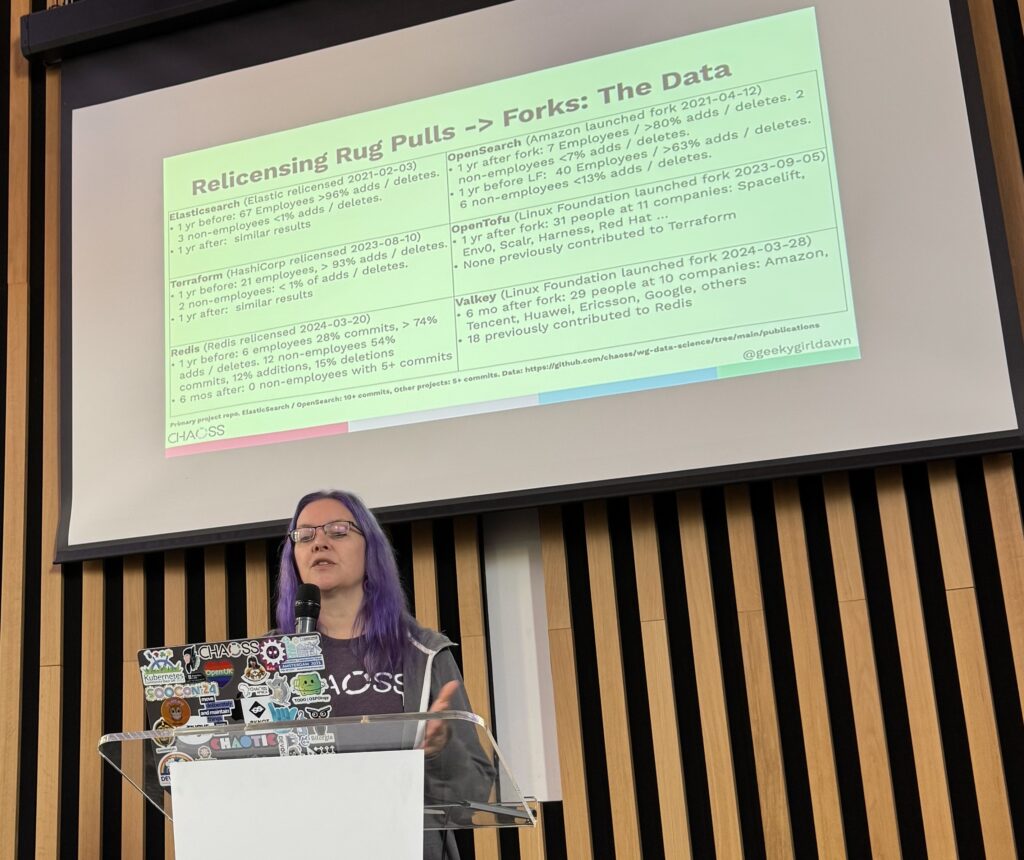
At the Monki Gras conference in London last week, Madelyn Olson, who created the Valkey project which forked Redis following its license change, described how it happened. Meanwhile, another speaker showed statistics demonstrating how Redis changed from having substantial external contributions to having almost none.
Monki Gras is organized by developer-focused consultancy Redmonk.
In March 2024 Redis CEO Rowan Trollope announced a change of license from the three-clause BSD (Berkeley Software Distribution) to dual licensing under Redis Source Available License v2 and Server Side Public License. The reason given was to “allow us to sustainably provide permissive use of our source code,” with the key remark being that “under the new license, cloud service providers hosting Redis offerings will no longer be permitted to use the source code of Redis free of charge.”
Olson, a principal software engineer at AWS, was at the time one of five members of the Redis core team, and one of two from outside companies, the other being Zhao Zhao, a senior engineer at Alibaba Cloud, which, like AWS, offered a managed Redis service.
The license change was “very unexpected,” Olson told Monki Gras. The company “very kindly informed me I was no longer a maintainer by deleting it from the governance stuff … they were very apologetic. It was them, not me.”
Olson’s contributions were not small ones. “My first major contribution to the project is I actually added TLS,” she said. “In 2018 I went to RedisConf and pestered Salvatore [Sanfilippo], the creator of Redis … about why he was wrong about TLS and why he should merge it into the engine. It took me about two years from that point to actually get that code into the engine.”
Olson told attendees that she had been excited to become a Redis maintainer and that she “convinced my leadership within Amazon that I should spend all of my time working on Redis open source because it was good for our end users. So I was deeply involved in the project, and I was kind of pissed off and mad and angry when Redis decided to kick me out and change the license.”
She got together with Zhao, who had been similarly affected, and created the fork which became Valkey, announced with remarkable speed as an intent of the Linux Foundation. The project had the support of AWS, Oracle, Google Cloud and others.
Valkey is open source on GitHub under the BSD 3-clause license and had just released version 8.1.0, a minor release with mainly bug-fixes and performance-focused changes.
The goals of Valkey, Olson said, are to “try to modernize the engine, try to adopt new architectures or data structures to take better advantage of modern hardware, as well as trying to build on features that everyone was looking for us to build … we still want to keep the engine simple, which was a goal of Redis, but we were more willing to embrace complexity.”
The governance and community aspect is also important. Valkey is a multi-vendor project and currently has six maintainers, one each from Tencent, Huawei, Amazon, Google, Alibaba and Ericsson. When on the core team at Redis, Olson said, there were “private meetings, and these meetings were often simply told outcomes … it was often on me or Zhao to tell the community what had happened, whether or not a feature was accepted, whether or not a design was approved.”
This time around, the Valkey project “vowed to do something very different” by trying to do as much as possible in public and to be open and inclusive. One aspect of that is that meetings are held at a time which allows members in China to attend, “some of whom don’t speak great English,” and using AI real-time translation to “allow them to participate in the community.”

Dawn Foster, director of data science for the CHAOSS (Community Health Analytics in Open Source Software) project, also part of the Linux Foundation, spoke earlier at Monki Gras about “rug pulls,” where the basis on which a critical piece of software is provided is suddenly changed. She referenced Redis as one of three examples, the other two being Elasticsearch and Hashicorp Terraform, all of which had license changes away from open source, and all of which were forked by companies keen to continue with an open source equivalent.
The Redis case is distinctive, Foster said, because it was the only one where the number of active contributors from outside the sponsoring company (Redis Inc) changed substantially after the license change and fork. Before the fork, 12 non-employees made 54 percent of commits, amounting to 12 percent of the additions and 15 percent of the deletions from the code, according to her data, whereas afterwards there were zero non-employees with more than 5 commits.
The implication is that the creation of Valkey has had a substantial impact on the Redis project, and not only because it has resulted in more competition.
In December 2024, Sanfilippo (also known as antirez) rejoined Redis, noting that “perhaps I could be able to reshape the company’s attitude towards the community. Maybe I could even help to take back the role of the Redis core as the primary focus of new developments.”
The reason why Redis Core might get a new focus is that when it was completely open source, this gave Redis an incentive to put new features into modules under a different license. This has now changed.
Sanfilippo said that while “I don’t have huge issues with Redis changing its license” he recognized the “fracture with the community.” He said that although the new license is not OSI (Open Source Initiative) approved, it nevertheless takes “a copyleft approach” and should not be described as closed.
Sanfilippo also noted that “with the new license, cloud providers can’t just cut and paste the Redis code base and sell it without any revenue sharing (was this really asking for too much? This could have prevented all the license switches you saw lately, not just Redis).”
The rationale for the license change was not mentioned by Olson at Monki Gras, even though it seems obvious that the ability to keep on providing a similar service without any licensing cost is a major incentive for AWS, Alibaba and others to support Valkey.
The focus of Monki Gras this year was on sustainable software craft. In an open source context, sustainable means getting sufficient support from sponsors, and Valkey looks good in this respect, particularly with the added benefit of Linux Foundation adoption. What about the sustainability of Redis, which was the reason for the fork in the first place? It is too soon to say; though a report last year from Redmonk showed little financial impact in other similar cases.
